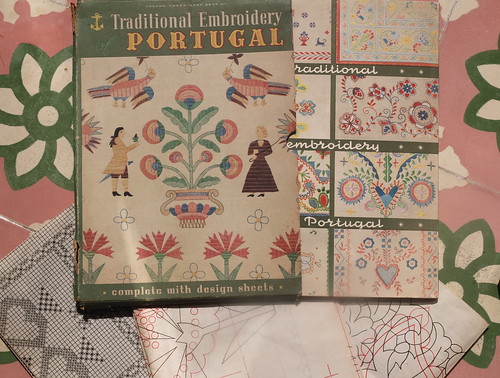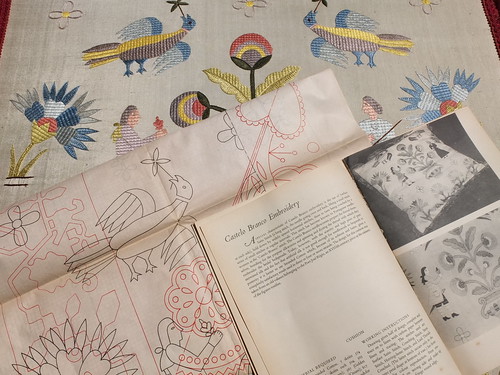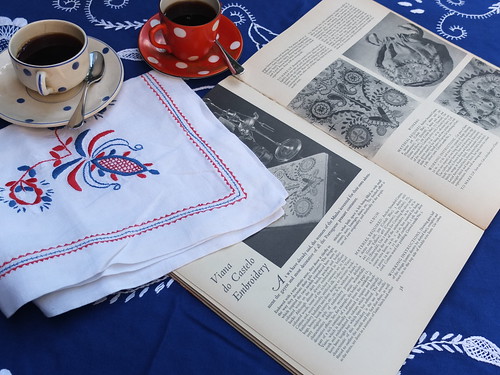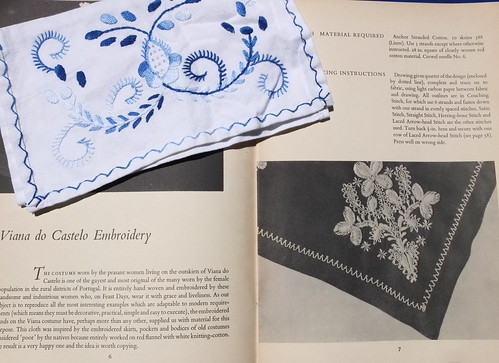 |
| Cardboard slipcase, back cover and three design sheets, my photo |
Now I'm becoming unbearably smug!!!
I bought it some weeks ago while I was doing the research for my first post and the moment I received it I decided to write on it.
There are more second hand copies, so run if you want to buy one!
It's a beautiful book that comes inside a cardboard slipcase with three design sheets. The cover illustrates the traditional embroidery of Castelo Branco and the pattern is exactly the same, although in different colors, as the one I showed on my first post. The back cover is wonderful, so colorfully showing many different Portuguese motifs. But color remains outside the book... Unfortunately it's a black and white book. That's why I decided to balance the lack of color... I've searched my drawers to find some embroidery pieces that could colorfully illustrate some of the embroidery types described in the book. I hope you like it...
 |
| Madeira embroidery - my photo |
 |
| Castelo Branco embroidery - my photo |
 |
| Viana do Castelo embroidery - my photo |
 |
| Azores embroidery - my photo |
 |
| Viana do Castelo Embroidery, my photo |
This photo also shows an even "more modern" piece also inspired by the same motifs. It is a napkin-bag that came from my mother's drawers...
The regional traditional embroideries represented in the book are: Viana do Castelo, Azores, Castelo Branco, Caldas da Raínha, Guimarães, Tibaldinho, Madeira and Nisa. Some important stitches are also illustrated: chain stitch embroidery, cross stitch embroidery, shaded embroidery, net embroidery and "dove's eye" embroidery.
Although they seem many, I assure you that some more are missing... And I'll try to review all them throughout this year...
I could not end this long post without highlighting the impressive "backstage" work involved in this book. We can find around twenty eight modern pieces reproduced and that´s why it is fully understandable the reason why the author expresses her deep gratitude to the embroideresses...
In addition to the word "livro" (book), and after such a big post, I have to teach you another Portuguese word that expresses my feeling in case you've reached here... Obrigada - thank you!




Lovely and inspiring! I have truly enjoyed learning about Portuguese embroidery. Keep the posts coming!
ReplyDeleteObrigada! Isn't it a shame that they did not have access to color photography for this book? It is so difficult for me to imagine color on a black and white pattern. Thank you for taking time to explain the book and add your own colorful work, as well.
ReplyDeleteReally a treasure, Gabi!!! :)
ReplyDeleteWhat is "dove's eys"??? Never heard about that stitch...
Another enjoyable post Gabi, I really appreciate all the effort you have put into explaining the different Portuguese stitches. I like the idea of the Napkin Bag.
ReplyDeleteThank you for such an interesting post, I am really enjoying learning about Portuguese embroidery. My great-grandparents were Portuguese and I've always wanted to visit your beautiful country. I look forward to your posts every Thursday.
ReplyDeleteObrigada! Hard to decide what I like better, the colorful, cheerful Castelo Branco sample or the understated but beautiful Azores sample. They are so different! But I like them both.
ReplyDeleteThis looks like an amazing book. Thank you so much for your wonderful post.
ReplyDeleteLucky you finding this book! What a great way to introduce traditional Portuguese embroideries ... feeling very proud! x
ReplyDeleteThank you Gabi for this review. I'm portuguese and i feel that it's such a blessing to have been raised in a country full of beauty and tradition. Our embroidery represents a living common place to all the aspects of our identity. Congratulations for your work!
ReplyDeleteGabi, thank you for the great article review. Tenho andado a procura de kits e desenhos online com "Portuguese Themes" e gostei muito de ver o seu website e etsy store. Obrigado!
ReplyDeletethank you for the color photographs, they are quite stunning, though I admit, I most want to make a pretty white lace tablecloth as one of the pictures illustrates. I'll have to bookmark your blog so I can read all your other posts on embroidery. wonderful.
ReplyDeleteI bet that we all portuguese modern women still have a piece of this embroidery at home :)
ReplyDeleteI have a Viana do Castelo table cloth, and some from Azores as well.
You explained our country famous stitches beautifully Gabi, I'm really proud that you're blogging here!
Congrats!
Oh my gosh how beautiful is this! :-) Love it!
ReplyDeleteHi, I have a pocket just the same as yours in Viana do Castelo Embroidery photo. It belonged to my husband's grandmother. Beautiful work.
ReplyDeleteWows its looks great. You did a great job.
ReplyDeletesuch a great article about traditional embroidery of portugal.its really successful work.
ReplyDeletenice work Regular sewing is
ReplyDeletethe art of attaching or linking things using stitches made with a needle and
thread.Regular sewing is one of the earliest of the textile arts.Sewing is
the essential process actual a wide range of fabric artistry and crafts